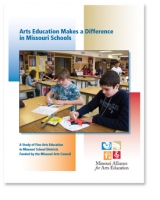Arts Education Makes a Difference in Missouri Schools
GENERAL
The Missouri Arts Council (MAC), a state agency dedicated to broadening the appreciation and availability of the arts in our state, is pleased to support the completion and release of “Arts Education Makes a Difference in Missouri Schools.”
We at MAC believe that the arts play a vital role in the life and well-being of our communities; this includes the belief that all children in our state deserve access to quality education in the fine arts.
MAC was pleased to be a catalyst and partner in this important study, which was made possible through the tireless effort of the leadership of the Missouri Alliance for Arts Education and the cooperation of representatives from the Missouri Department of Elementary and Secondary Education.
We believe this report makes a significant contribution to what we know about the fine arts in our state’s schools. It provides strong support for maintaining, if not increasing, the current levels of arts education available to Missouri students, even in these uncertain economic times.
As we continue to address MAC’s strategic goal, Strengthen Missouri Education Through the Arts, with the objective of advocating for arts education in Missouri schools by supporting Missouri evidence-based research on learning through the arts, we hope this report will provide the much-needed evidence for the educators, administrators, policy-makers, parents, students, and others who advocate for quality arts education in the State of Missouri. [Letter from Beverly Strohmeyer, p. 4]
According to an analysis of “core” data submitted to the Missouri Department of Elementary and Secondary Education by the state’s public school districts, fine arts education is significantly related to higher standardized test scores, higher attendance and graduation rates, and lower disciplinary rates for serious student infractions.
Specific findings include the following:
- Nearly all students in Missouri public schools have opportunities to participate in fine arts education, particularly in the areas of Visual Art and Music. Course offerings in Dance and Theater are limited.
- The level of student participation in fine arts classes at the district level is highly correlated to student disciplinary rates. That is, the higher the number of fine arts courses and the student enrollment in these courses1, the lower the rate of infractions that require student removal from the classroom.
- Attendance rates are higher for districts with higher levels of student enrollment in the arts when compared to districts with lower levels of arts participation.
- Levels of student participation in arts education are significantly correlated to multiple measures of student proficiency in Mathematics, with higher arts participation equaling higher Math scores (on standardized tests) at the district level.
- Standardized test scores in Communication through eighth grades, are also significantly higher in districts with more arts participation.
- Student participation in arts education shows a significant and positive correlation with high school graduation rates. Missouri school districts with higher levels of student participation in the arts showed higher graduation rates than districts with lower levels of arts education.
- When controlling for district poverty levels, the relationships between arts participation and indicators of positive academic performance are still significant, particularly in the following areas: disciplinary rates, high school graduation rates, and standardized test scores in Math and Communication Arts.
- When controlling for the percentage of minority students (or racial/ethnic groups that tend to show lower levels of academic achievement), the link between arts education and positive district/student indicators was still significant for the following: disciplinary rates, graduation rates, and standardized test scores in Math and Communication Arts.
According to an analysis of “core” data submitted to the Missouri Department of Elementary and Secondary Education by the state’s public school districts, fine arts education is significantly related to higher standardized test scores, higher attendance and graduation rates, and lower disciplinary rates for serious student infractions.
Specific findings include the following:
- Nearly all students in Missouri public schools have opportunities to participate in fine arts education, particularly in the areas of Visual Art and Music. Course offerings in Dance and Theater are limited.
- The level of student participation in fine arts classes at the district level is highly correlated to student disciplinary rates. That is, the higher the number of fine arts courses and the student enrollment in these courses1, the lower the rate of infractions that require student removal from the classroom.
- Attendance rates are higher for districts with higher levels of student enrollment in the arts when compared to districts with lower levels of arts participation.
- Levels of student participation in arts education are significantly correlated to multiple measures of student proficiency in Mathematics, with higher arts participation equaling higher Math scores (on standardized tests) at the district level.
- Standardized test scores in Communication through eighth grades, are also significantly higher in districts with more arts participation.
- Student participation in arts education shows a significant and positive correlation with high school graduation rates. Missouri school districts with higher levels of student participation in the arts showed higher graduation rates than districts with lower levels of arts education.
- When controlling for district poverty levels, the relationships between arts participation and indicators of positive academic performance are still significant, particularly in the following areas: disciplinary rates, high school graduation rates, and standardized test scores in Math and Communication Arts.
- When controlling for the percentage of minority students (or racial/ethnic groups that tend to show lower levels of academic achievement), the link between arts education and positive district/student indicators was still significant for the following: disciplinary rates, graduation rates, and standardized test scores in Math and Communication Arts.
BIBLIOGRAPHY






